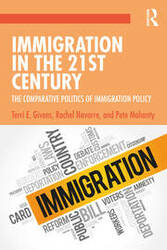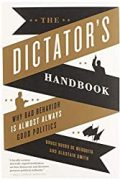
Rating: 7.2/10.
Immigration in the 21st Century: The Comparative Politics of Immigration Policy by Terri Givens, Rachel Navarre, Pete Mohanty
A academic book that discusses the history and politics of immigration, with a primary focus on the US, Australia, and Canada, and countries in Europe, including Britain, France, and Germany. It explores how these countries view immigration, race, and citizenship differently. The writing style is fairly academic and can be a bit difficult, as it contains many citations to other academic works and many sentences are precise quotations rather than easily understandable narratives. The focus is mostly on history and politics, less about economic analysis, and it focuses on the Western world and doesn’t mention any immigration in other places such as Asia other parts of the developing world.
Chapter 1: The British colonies in the US, Canada, and Australia started as colonies, so they are perceived as having high levels of immigration in both the past and the present. However, all of them have actually experienced periods of pro and anti-immigration. Global attitudes towards immigration changed after 9/11. Immigrants usually move to more developed areas with more opportunities.
Broad history of immigration: In the US, immigration was largely unregulated until the Civil War, after which it became more formalized. In contrast, in Europe, immigration was a more recent phenomenon, beginning in the 70s. The US, Canada, and Australia have had large and steady immigration rates since World War II, continuing to the present day. In Germany, there was a large influx of immigrants after the fall of the Berlin Wall, and more recently from Arab migrants following the Arab Spring.
Chapter 2: The federal government generally proposes the policy for immigration, which is then passed by the legislature. Citizenship models can be: republican, meaning that it is not based on ethnicity, but rather on adherence to a country’s laws and values. This is in contrast to the ethnic model, which carries a stronger expectation for shared ethnicity and culture. Immigrants often have positive financial impacts on a country, especially if they are highly educated.
Around 2014, there was a large influx of Syrian refugees in Europe, which raised questions about how to handle these refugees and asylum seekers. Australia was unusually unwelcoming to refugees, placing them on remote islands to prevent them from setting foot on Australian soil. Liberal democracies tend to accept more refugees and asylum seekers than originally intended because they place a high value on human rights issues.
Chapter 3: In the US, there wasn’t much opposition to immigration until the late 1800s, after the Civil War. The first group to face limitations was the Chinese in 1882, through the Chinese Exclusion Act. During that time, the Chinese were similar to today’s Hispanic population; they were willing to work for lower wages, which was beneficial for businesses but detrimental for the working class. In the 1910s, there were proposals for more stringent tests for immigrants to conform to the English majority in language and customs. This was aimed at limiting immigration, not just for the Chinese, but also for those from Eastern and Southern Europe; these proposals were based on the then-popular ideas of racial superiority. After World War II, there was a significant increase in Mexican immigration, leading to debates about how to handle the situation, however, different levels of government disagreed on the policies for them. After the 9/11 attacks, there were major changes in the enforcement of immigration policies. Throughout the post-war period, there were many attempts at immigration reform, but most of them lacked enough broad support to change the policy. Australia and Canada followed a broadly similar trajectory to the US, since they were also settled colonies with high amounts of immigration. They showed a preference for skilled workers, based on a point system.
Chapter 4. In Britain, there was a lot of immigration from the colonies from the 1950s to the 70s, which quickly prompted changes in policy based on race. The restrictive Immigration Act of 1971 that drastically limited immigration, including family reunions. In France, immigration was fairly free until the 70s, then, a lot of media attention was drawn to the living conditions of migrants, leading to a far-right anti-immigration sentiment that continues today, especially after multiple Muslim terrorist attacks.
Chapter 5. Immigration in Germany – in the 60s, Germany opened up for the first time to non-Germans, partially to distance themselves from the Nazi regime. The intention was to bring in temporary workers on a rotational basis, not for them to settle permanently. There was some political blowback after a recession and unemployment, with many people blaming this on the foreign workers. In the late 70s, there was a shift towards integration rather than relying on temporary workers. In the 2000s, there was a push towards increased immigration, following the success of Canada and Australia. However, the events of 9/11 dampened the sentiment significantly. Currently, there is a lot of anti-immigration sentiment due to the large influx of refugees to Germany from the Middle East. The EU generally tries to harmonize immigration policies, but there are regional differences in how immigration is viewed, creating tension for the Schengen borderless agreement. The UK and Ireland are not affected as they have their own border controls.
Chapter 6. The political right usually wants to restrict immigration and implement stricter border controls, whereas the political left advocates for expanded social services for immigrants, viewing them as potential future voters similar to themselves. In all European countries, there have been radical right parties focused on reducing immigration. In Britain, immigration led to overcrowding, which in turn led to anti-immigration sentiment. The Conservative Party was elected to stop the immigration, and concerns about immigration were a large part of the rationale for Brexit in 2018. In France, the Front National (FN) represents anti-immigration views; they have existed since the 80s but rose in popularity in 2014. In the US, President Trump issued anti-immigration executive orders on racial grounds, but these were stopped by the courts as unconstitutional.
Chapter 7. Businesses usually favor immigration as it leads to a larger workforce and lower wages. On the other hand, workers generally perceive it as depressing wages; this is the case even for highly skilled workers, such as those with an H1B visa. The evaluation of highly skilled workers can be done using a point system, but this risks detaching points from actual employability. An alternative is requiring a job offer, but this may cause immigrants to become tied to an employer and subsequently exploited. Canada uses a hybrid system that requires both points and a job offer. As a result, Canada has a much higher number of employment-based migrants than the US, but a similar level of family reunification. Whether or not immigrants actually reduce domestic wages is an open question, but some experiments in Florida have shown that they do not significantly affect domestic wages, even if they are illegal immigrants from Cuba.
Chapter 8: How countries view citizenship. France has historically held a more assimilationist view of nationality, which has never been race-based, they made it easy for North Africans to assimilate and gain citizenship, but recently, due to some political pressures from the far right, stronger requirements have been imposed for immigrants to integrate into the French culture. On the other hand, Germany has historically viewed nationhood as primarily ethnic, and it was very difficult for foreigners to ever become citizens until recently. However, this has been relaxed somewhat, allowing those who were born in Germany to become citizens if their parents have been living in the country for a long time. Some discussion of the idea of a transnational citizen, which is not specific to any country due to the borderless agreement of the EU, but this has generally not materialized.
Chapter 9: Immigrant integration is a more important issue in European politics than in the US, but countries disagree about the specifics and what integration means. The Netherlands introduced civic requirements after a large number of immigrants in the 2000s did not learn Dutch and became unemployable. The US’s laws on migrants were quite different, following a different historical path because there was a significant black minority from slavery, which prompted the civil rights movement, whereas Europe had relatively few minorities prior to the 60s.



